- Author: Kathy Keatley Garvey
If you engage in a mini-monarch conservation project, you know the joy of watching the egg-caterpillar-chrysalis-adult transformation. It's one of Nature's miracles.
Then when you release the monarchs and watch them soar high, awkwardly fluttering their wings in new-found freedom, that's another high.
But there comes a day when you realize that Nature isn't perfect--not that you ever thought it was or ever will be.
In fact, Nature can be a little cruel.
Take the case of several caterpillars we reared in an enclosed habitat to protect them from predators. The 'cats ate the milkweed, and then, they formed chrysalids, just like they're supposed to do. Perfectly formed green-jade chrysalids dotted in gold.
They all looked normal, except one. Apparently a very hungry caterpillar chomped on one of the chrysalids instead of its milkweed. It knawed and knashed until it cratered it.
"This is it!" we figured. All done. No more left to eclose. But today, a monarch eclosed from the damaged chrysalis. A monarch with a deformed wing.
It was a girl. It still is.
We placed her on a broadleaf milkweed (Asclepias speciosa), where she sunned herself and warmed her flight muscles--flight muscles she'll never use because she cannot fly. She sipped some sugar-water and a chunk of juicy watermelon.
She may even attract a mate and give us the next generation.
Maybe. Maybe not.
Nature is not always nice.
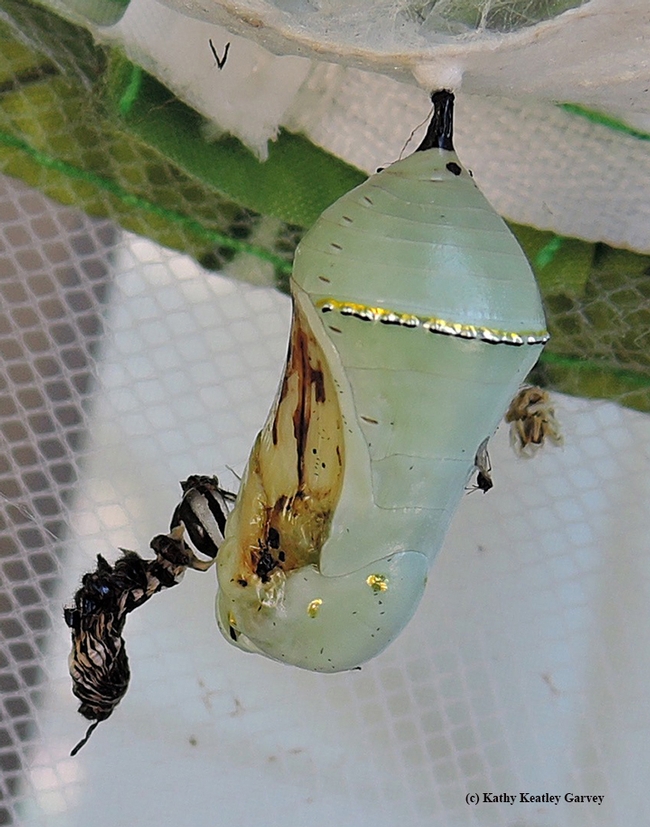
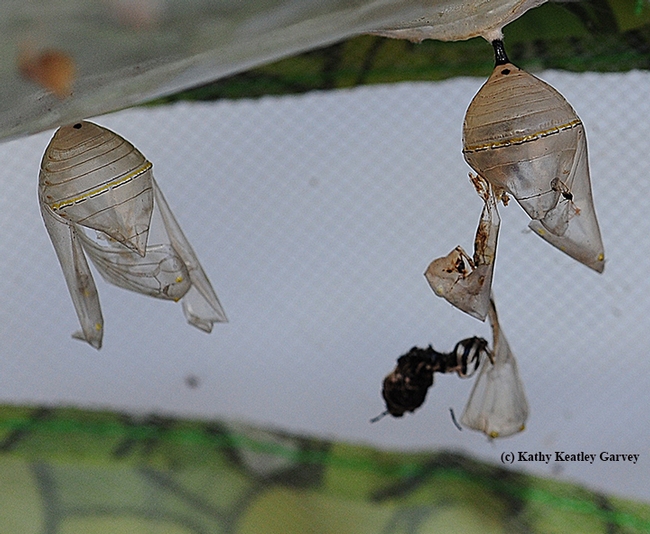
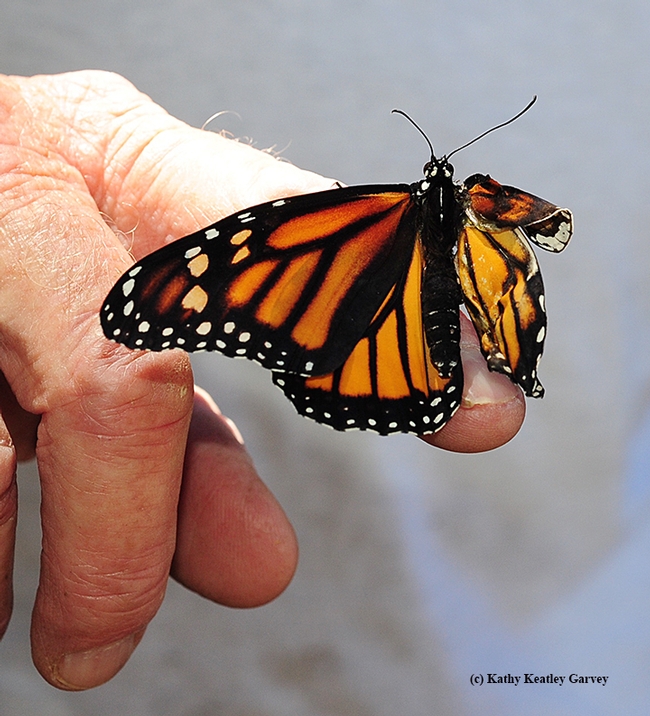
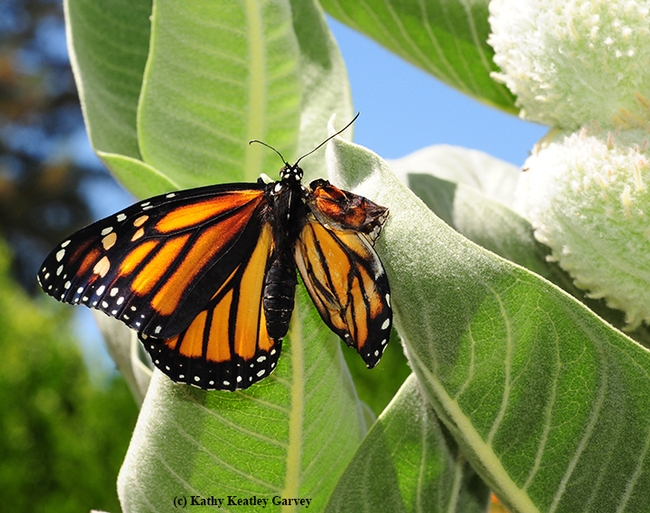
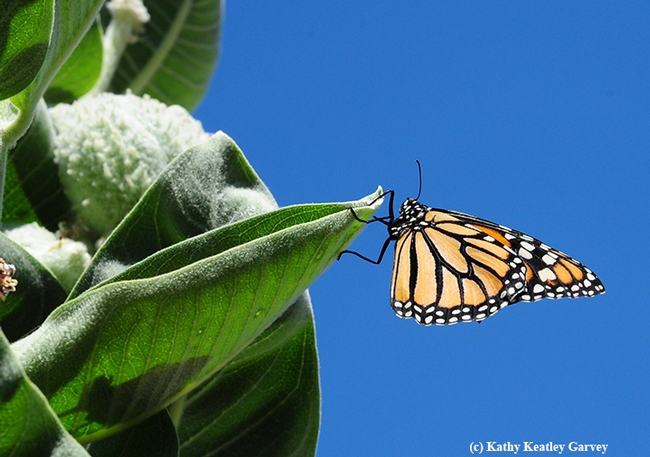
- Author: Kathy Keatley Garvey
Sometimes caregivers, including grandparents, aunts, uncles, cousins and neighbors, take photos of babies to show "proof of life." They post them for the parents to see, admire and confirm.
It's delightful to see images of your offspring while you're on vacation, on a business trip, or just out and about.
Same with monarch caterpillars. "Monarch Moms" and "Monarch Dads" take "proof-of-life" photos.
Often we'll see a hungry monarch caterpillar chomping and chewing and gorging on milkweed. It's a pretty sight, these chunky white caterpillars banded in yellow and black doing what they do best--eating. Some day they'll form a "J" and then a jade-green chrysalis rimmed with gold. And then--voila!--an adult monarch will eclose.
Some day, but maybe not.
A predator may nail them.
We recently noticed a Missing-in-Action caterpillar from our showy milkweed, Asciepias speciosa, and a quite contented Western scrub jay looking like the cat that ate the canary, or the scrub jay that ate the 'cat. Note that the jays nest in our trees, and to nourish them, we feed them seeds year-around in the birdfeeder.
The birdfeeder, however, happens to be located right next to the 8-foot showy milkweed where monarchs lay their eggs.
Jays apparently like a varied diet. Like a fat juicy worm (to them). Yum? Not yum. It does not taste good. Species in the genus Asclepias produce the toxic cardiac glycosides and this helps protect the caterpillars from predators. Although they don't taste good, they will still eat a few.
The photos below are proof of life of one hungry, thriving caterpillar. The next day? Gone. It became a bird's dinner.
But not its sibling caterpillar. We rescued it and fed it and watched it form a chrysalis. Soon an adult monarch butterfly wlll eclose. This one will be "proof of life."
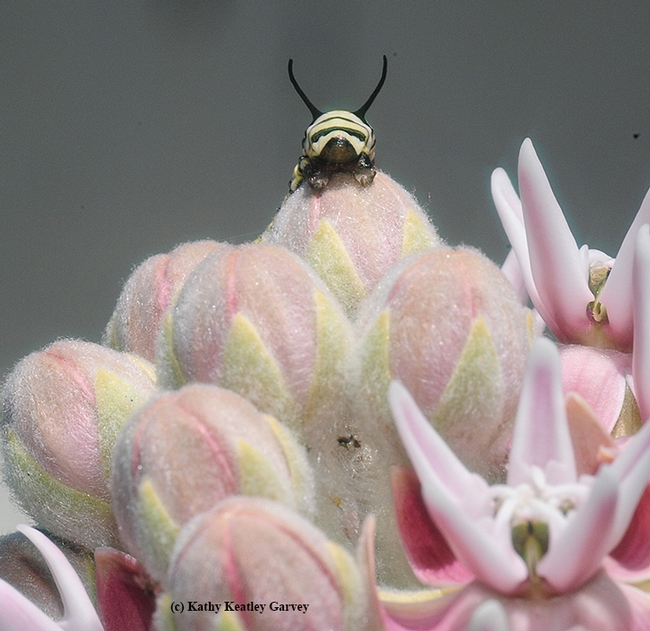


- Author: Kathy Keatley Garvey
So here's this tattered old worker bee seeking some nectar from the broadleaf milkweed, Asclepias speciosa. She looks as if she's not only been around the block a few times but around the county several dozen times. Her wings look too ragged to support her flight back to her colony. She'll probably live just a few more days. Worker bees live only four to six weeks in the peak season, and this is the peak season.
She bends her head and sips nectar, only to realize she is not alone. She encounters long antennae...the long antennae of a monarch caterpillar munching on a blossom. Whose plant is this? The bee wants the nectar. The monarch caterpillar wants the entire plant. This is the larval host plant of the monarch butterfly, Danaus plexippus. The caterpillars turn into veritable eating machines, devouring the leaves, flowers and some of the stems. Without milkweed, no monarchs. It's a matter of survival.
The tattered old bee touches antennae with the hungry caterpillar--Well, hello, there, dining companion!--and she backs off. There will be another blossom--if she moves quickly to claim it.
Another bee, this one much younger than the senior citizen bee, buzzes over to nearby blossom while another caterpillar, partially hidden, munches away. The bee gets stuck in the sticky mass of gold pollinia and struggles to free herself, just as another bee flies off with some of that gooey "winged" substance, anchoring her flight. She will remove it. She will return. The nectar is too enticing.
Just another chapter in the Saga of the Milkweed, the Bee and the Caterpillar...
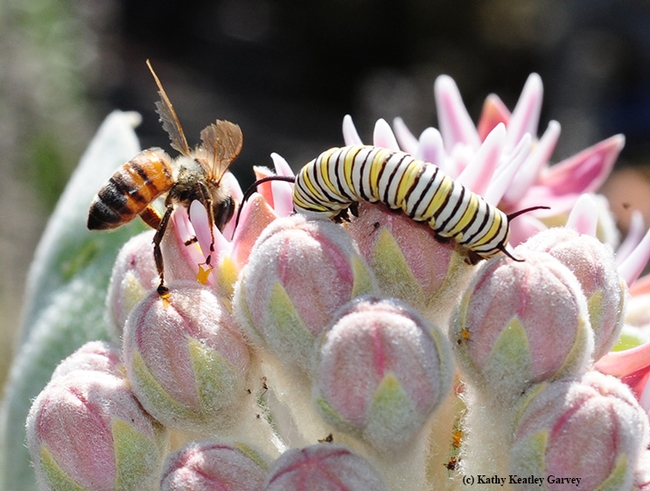

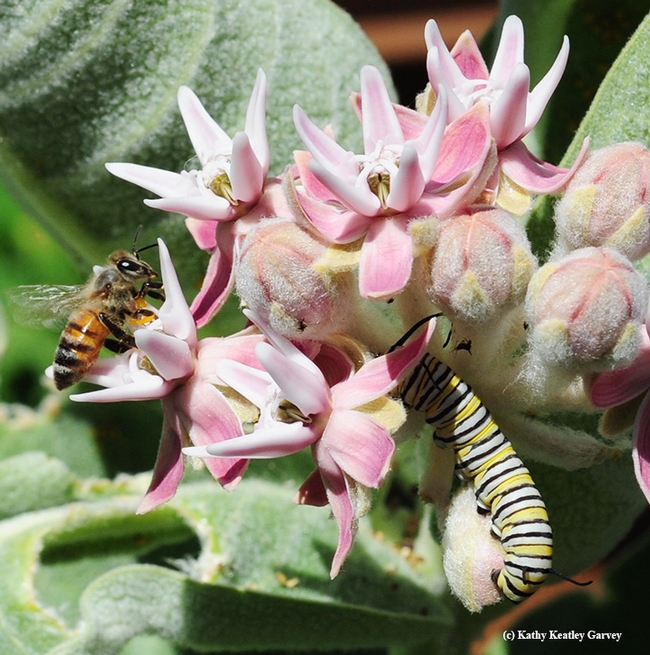

- Author: Kathy Keatley Garvey
How times change with the advancement of knowledge.
It's long been known that when honey bees—as well as other insects—get trapped in the milkweed's pollinia, or sticky mass of pollen, many perish when they are unable to free themselves.
So when we were perusing the book, ABC of Bee Culture, published in 1890 and written by noted beekeeping innovator/entrepreneur A. I. Root (1839-1923) of Ohio--with information “gleaned from the experience of thousands of beekeepers from all over the land”--we came across a surprising recommendation.
The surprising recommendation: If you want to kill off bees where they are not wanted, plant milkweed. In one reference, milkweed is described as a “useless weed.” (Actually, it's the only larval host of the monarch butterfly and without milkweed, no monarchs.)
Excerpt from ABC of Bee Culture:
"Milkweed (Asclepias cornuti). This plant is celebrated, not for the honey it produces, although it doubtless furnishes a good supply, but for its queer, winged masses of pollen, which attach themselves to the bees's feet and cause him to become a cripple, if not to lose his life. Every fall, we have many inquiries from new subscribers in regard to this queer phenomenon. Some think it is a parasite, others a protuberance growing on the bee's foot, and others, a winged insect enemy of the bee.” (Note that foragers are referred to as male, but all foragers are female.)
“It is the same that Prof. Riley alluded to when he recommended that the milkweed be planted to kill off the bees when they become troublesome to the fruit grower. The folly of such advice—think of the labor and expense of starting a plantation of useless weeds just to entrap honey bees---becomes more apparent when we learn that it is perhaps only the old and enfeebled bees that are unable to free themselves from those appendages, and hence the milkweed can scarcely be called an enemy. The appendage, it will be observed, looks like a pair of wings, and they attach themselves to the bee by a glutinous matter which quickly hardens so it is quite difficult to remove, if not done when it is first attached.”
There's a wealth of information in the encyclopedic ABC of Bee Culture, even the 126-year-old edition, but planting milkweed to kill bees and describing milkweed a "useless weed" aren't two of them.
How times change with the advancement of knowledge.
(Editor's Note: The newest edition of the ABC of Bee Culture is The ABC and Xyz of Bee Culture: An Encyclopedia of Beekeeping, 40th Edition. It's published by the A. I. Root Co.)
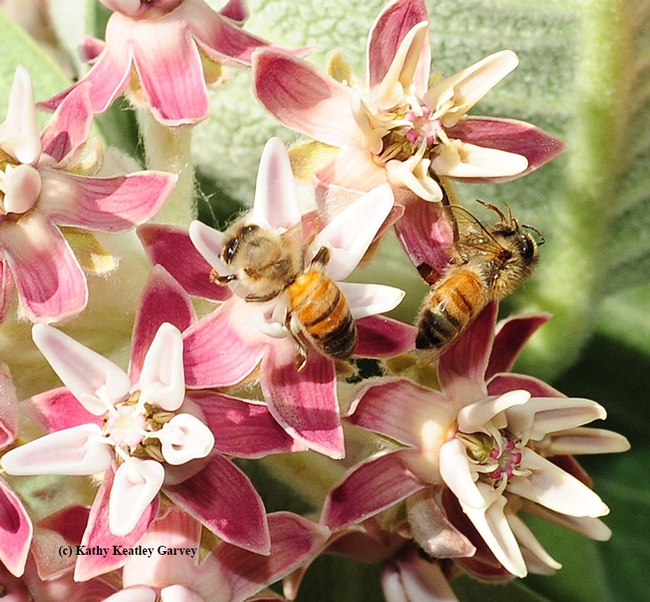
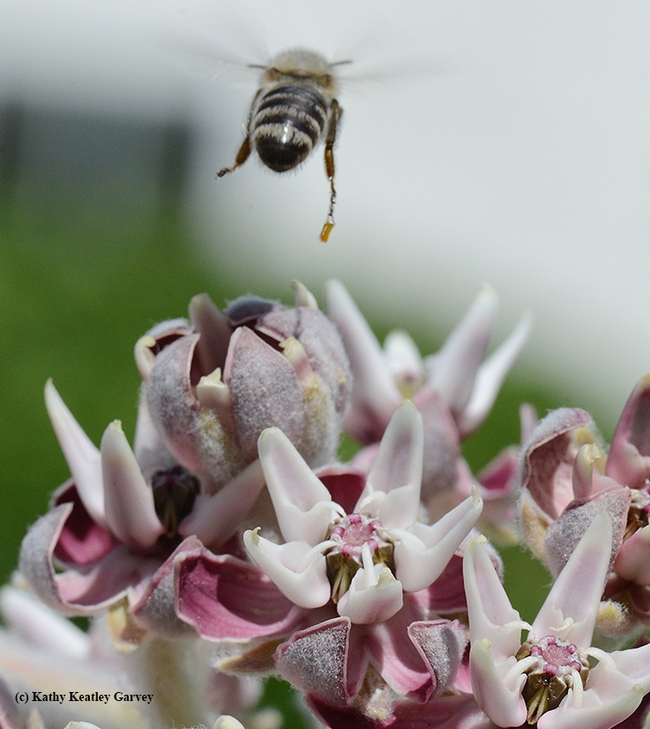
- Author: Kathy Keatley Garvey
For the last several months, we've seen monarchs laying eggs on our narrow-leafed milkweed.
A daily check yielded "zero" caterpillars. Zero. Nada. Zilch. One reason is apparent: two nearby nests of Western scrub jays filled with chirping babies. Birds aren't known for eating a large quantity of monarch caterpillars--they don't taste good--but they will still eat a few.
They didn't eat this one.
It was tucked away, hidden from sight. Then we found another caterpillar, also hidden.
In the interests of conservation--and to prevent predation--we placed them inside our indoor butterfly habitat, purchased last year from the gift shop at the Bohart Museum of Entomology, the University of California, Davis.
The rest, as they say, is history and herstory. A male eclosed from the first chrysalis, and a female from the second.
It's one of Nature's miracles. From an egg, to a caterpillar to a chrysalis to an adult Danaus plexippus.
One week, it's a hungry fifth-instar caterpillar...then it's a gold-dotted, jade-green chrysalis, a joy to see. When the chrysalis turns transparent, you can make out the colorful butterfly inside--Nature's gift that's soon to eclose.
From chrysalis to adult, the male took 10 days.
From chrysalis to adult, the female took 9 days.
We've already released the male. He soared high into the sky, at least 80 feet, and headed for an oak tree as a Western scrub jay eyed him. Whew! The predator did not pursue him.
The second monarch, the female, just eclosed this afternoon. It's Freedom Day tomorrow.







